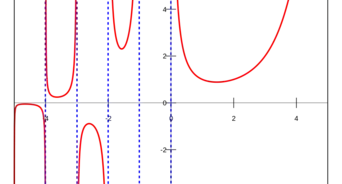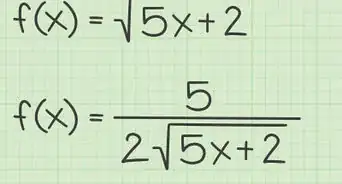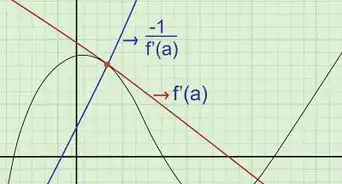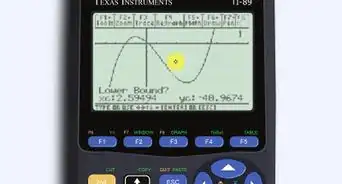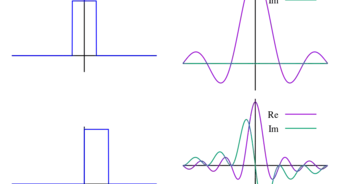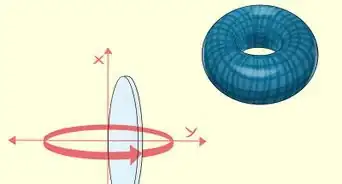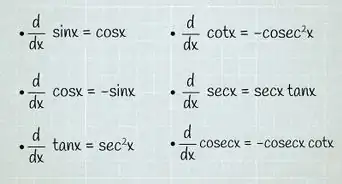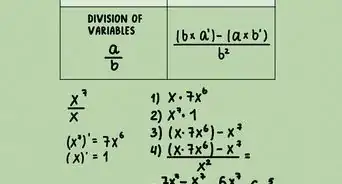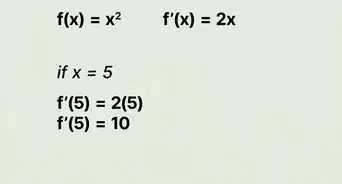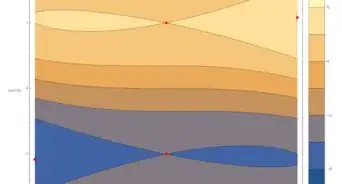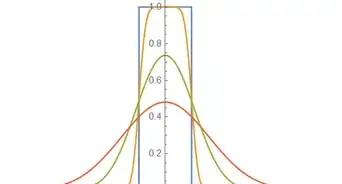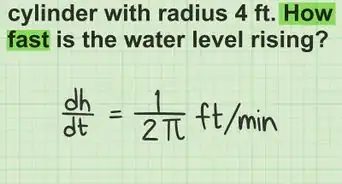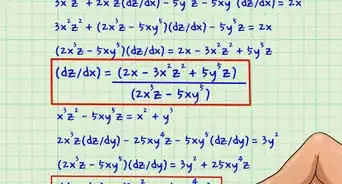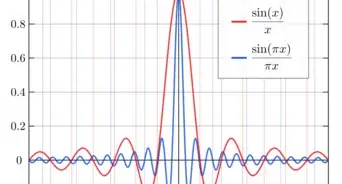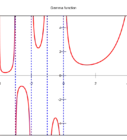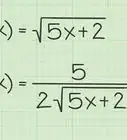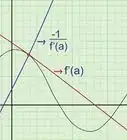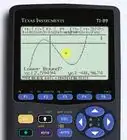X
wikiHow is a “wiki,” similar to Wikipedia, which means that many of our articles are co-written by multiple authors. To create this article, volunteer authors worked to edit and improve it over time.
This article has been viewed 22,225 times.
Learn more...
The Beta function is a very useful function for evaluating integrals in terms of the Gamma function. In this article, we show the evaluation of several different types of integrals otherwise inaccessible to us.
It is important that you understand the Gamma function and how to evaluate integrals using its Taylor expansions before proceeding. This article will be written assuming you are proficient with such integrals.
Preliminaries
- The Beta function is defined as the ratio of Gamma functions, written below. Its derivation in this standard integral form can be found in part 1. The Beta function in its other forms will be derived in parts 4 and 5 of this article.
- In this article, there are a few important relations that will be used. One of them is Euler's reflection formula for the Gamma function, important for simplifying answers that may otherwise appear transcendental.
-
Legendre's duplication formula will be used as well. It relates the expansion of Gamma at to those at We derive this formula using the Beta function in part 2. Below, we write a ratio that will be seen in the examples to come, where is a small number.
Steps
Part 1
Part 1 of 7:
Deriving the Beta Function
-
1Begin with the product of two Gamma functions. This product is the first step into deriving the standard integral representation of the Beta function.
-
2Advertisement
-
3Make the u-sub . Rewrite the double integral in terms of and Now we see that the first integral is simply
- Below, we go through three examples that make direct use of the Beta function.
Advertisement
Example 1
-
1Evaluate the integral below.
-
2Find and and substitute those values into the definition. We see that and just from inspection.
-
3Simplify. Use the recursion relation to write the numerator in terms of
Advertisement
Example 2
-
1Evaluate the integral below. We see that our integrand is not quite in the form that we want it to, but we can take advantage of the fact that and are arbitrary parameters.
-
2Make the u-sub . This gets the quantity inside the parentheses into the form that we want. We changed the exponent on the power term, but since is arbitrary, we don't have to worry.
-
3Evaluate using the Beta function. Simplify using the recursion relation to get the arguments of the Gamma functions between 0 and 1. Make sure your arithmetic skills are up to par.
Advertisement
Example 3
-
1Evaluate the integral below. Of course, the Beta function can also directly be used to evaluate these types of integrals with logs attached to them.
-
2Consider the integral below instead. This is standard procedure for an integral like this. We rewrite the power term so that is in the base and expand that into its Taylor series. Then we find the appropriate coefficient, neglecting higher-order terms because is small (and therefore they go to 0 faster).
- As seen above, we want to find the coefficient of
-
3Expand the Gamma function into its Taylor series up to first order. Since we are only finding the integral with the log to the first order, we can rewrite the terms in parentheses as exponential functions.
-
4Evaluate the integral by comparing coefficients. Our answer comes right out of our work.
- As usual, we get this integral for free, which can be evaluated the standard way.
Advertisement
Part 2
Part 2 of 7:
Deriving Legendre's Duplication Formula
-
1Begin with the integral below. We set
-
2Make the u-sub .
-
3Make a further substitution . Then we can get the integral into the form where we can directly use the Beta function.
- This is Legendre's duplication formula. It allows us to evaluate certain integrals that give us a during our work.
Advertisement
Part 3
Part 3 of 7:
Integrals with Two Logarithms
-
1Evaluate the integral below. We can also use the Beta function to determine integrals like these.
-
2Consider the integrals below. Since we have two logs, we need to introduce two parameters.
- Our integral implies that we need to find the coefficient of in the expansion, setting and Furthermore, we must multiply the eventual result we obtain by the factorial of the power. In this case,
-
3Expand the Gamma functions and the fraction. We see that the terms including the Euler-Mascheroni constant vanish. Furthermore, the terms in the sum cancel in a way such that only the cross terms are left intact. (We break up the exponential function into two to save space.) The fraction is expanded into its power series.
-
4Add the coefficients of . We need only terms up to and the Taylor series of that exponential function only goes up to first-order. We will also need terms of the power series up to third order. Remember that we do not need to multiply everything out. We are only interested in the coefficients of Be sure to keep track of the signs.
- Remembering to multiply by 2 to account for the factorial on this immediately gets us the desired result.
-
5Verify the integrals below. We can also show similar integrals using this technique. For the first one, we find coefficients of For the second one, we find coefficients of In principle, it is possible to evaluate integrals like these with any integer power on the logs. We would just have to keep more terms in our evaluation.
Advertisement
Part 4
Part 4 of 7:
Change of Variables
-
1Begin with the Beta function integral. In this section, we will show a u-sub that converts the Beta function into an integral from 0 to infinity, which will produce some very interesting results.
-
2Make the u-sub . This does two things. First, it allows us to directly evaluate integrals with in the denominator, which was previously not allowed. Second, it changes the boundaries. The way we now evaluate is to find first, and then find because of this substitution.
-
3Verify the integrals below. This form of the Beta function allows direct access to another class of integrals otherwise only accessible via residues. We can use Euler's reflection formula to simplify integrals, particularly the second one listed.
-
4Consider the integral below. We replace the term in the denominator with which after a u-sub, leads to more general results, since we can differentiate under the integral with respect to any of the three parameters. In particular, when we set we arrive at a very attractive answer involving the cosecant function (which we use the reflection formula to derive).
- These results can directly be used to evaluate more integrals. Verify these.
-
5Differentiate under the integral with respect to . The above result with the cosecant is a very potent integral because we can also differentiate once and twice to obtain some more results involving logs.[2] (We use a trig identity to simplify the result after differentiating twice.)
- Use these results to verify the integrals below. These integrals have extremely complicated antiderivatives, and there is virtually no hope of approaching them from the perspective of the fundamental theorem. However, these extremely simple answers only showcases the power of the Beta function - it makes the process of obtaining a simple answer, simple.
Advertisement
Part 5
Part 5 of 7:
Trigonometric Form
-
1Begin with the product of two Gamma functions. If you are familiar with the derivation of the Beta function, we start from the same place. However, we switch to polar and make a substitution to get a trigonometric integral.
-
2Make the u-subs and and switch to polar. Recall that the area element and the bounds for are from to because we are integrating over only quadrant I.
-
3Make the u-sub . After substituting and simplifying, we obtain our desired result. Be careful of the extra
- This is a very important result, and one that is very often used with integer powers, which provide very "nice" answers.
-
4Verify the following integrals. These are daunting with reduction of power formulae and other techniques, but trivial from the perspective of the Beta function.
Advertisement
Part 6
Part 6 of 7:
Logarithms of Trigonometric Functions
-
1Evaluate the integral below. The integral contains a composition of functions whose antiderivative cannot be written in terms of elementary functions. Nevertheless, the integral contains an exact solution.
-
2Consider the integrals below. As usual, we begin with the more general case of expanding into a series, neglecting higher-order terms, and finding the appropriate coefficient. These integrals will require the use of the duplication formula.
-
3Expand to the first order. After using the duplication formula, we see that the ratio cancels up to the first order, leaving us with a very simple expansion.
-
4Evaluate by equating coefficients.
-
5Verify the following integrals. This technique can once again be used to evaluate the entire class of integrals.
Advertisement
Part 7
Part 7 of 7:
Regularization
-
1Evaluate the integral below. This is an example of an integral that converges, but we cannot directly apply our techniques to evaluate because the integral that we would've considered does not converge.
-
2Consider the regularized integral. We need to add a term that "tames" the integral so that it converges. Otherwise, we would get a term that is undefined. Here, is a small number that is taken to be 0 at a convenient time.
-
3Multiply the top and bottom by . This gets our result into a form so that we can use a series expansion around Then we use the duplication formula.
-
4Expand and look for coefficients of . We are interested in the coefficient of but we need to find the coefficient of here in order to cancel the in front. Notice that any higher-order terms will vanish.
- Notice that the term cannot contribute to the coefficient because there is no term on the right. Therefore, the only terms that contribute are the cross terms.
- Notice that the term cannot contribute to the coefficient because there is no term on the right. Therefore, the only terms that contribute are the cross terms.
-
5Evaluate by equating coefficients. We can write our answer in terms of by making use of
-
6Verify the integral below. The work that was done to evaluate the first integral can be recycled to evaluate this similar integral.
Advertisement
References
About This Article
Advertisement
























![\int _{{0}}^{{1}}{\sqrt[ {3}]{x^{{2}}(1-x^{{4}})}}{\mathrm {d}}x](./images/1726160706-768e80a193168dbddf624305ca0a0848c4e41e41.webp)

![\int _{{0}}^{{1}}{\sqrt[ {3}]{x^{{2}}(1-x^{{4}})}}{\mathrm {d}}x={\frac {1}{4}}\int _{{0}}^{{1}}u^{{-7/12}}(1-u)^{{1/3}}{\mathrm {d}}u](./images/1815289576-ef2c1e09ee1517196cc7008f692215d7510648a2.webp)























![{\begin{aligned}{\frac {\Gamma (1+\epsilon )\Gamma (1+\delta )}{\Gamma (1+\epsilon +\delta )}}&=\exp \left[-\gamma \delta -\gamma \epsilon +\sum _{{k=2}}^{{\infty }}{\frac {(-1)^{{k}}\zeta (k)}{k}}(\delta ^{{k}}+\epsilon ^{{k}})\right]\\&\ *\,\exp \left[\gamma (\delta +\epsilon )-\sum _{{k=2}}^{{\infty }}{\frac {(-1)^{{k}}\zeta (k)}{k}}(\delta +\epsilon )^{{k}}\right]\\&=\exp \left[\sum _{{k=2}}^{{\infty }}{\frac {(-1)^{{k}}\zeta (k)}{k}}(\delta ^{{k}}+\epsilon ^{{k}}-(\delta +\epsilon )^{{k}})\right]\end{aligned}}](./images/2026774442-bfc11c3bc5238ce06b0e2d56644f74896ec7f053.webp)
















![\int _{{0}}^{{\infty }}{\frac {x^{{2}}{\sqrt[ {4}]{x}}}{(x+1)^{{4}}}}{\mathrm {d}}x={\frac {15{\sqrt {2}}\pi }{128}}](./images/2077892715-0b47bd8fcf21bb278c8f503645e9bea68ae2c3ce.webp)












































![{\begin{aligned}\cdots &={\frac {e^{{\delta \ln 2}}}{\delta }}\exp \left[\sum _{{k=2}}^{{\infty }}{\frac {(-1)^{{k}}\zeta (k)}{k}}\left(\epsilon ^{{k}}+\left({\frac {\epsilon +\delta }{2}}\right)^{{k}}+\left({\frac {\delta }{2}}\right)^{{k}}-\left({\frac {\epsilon }{2}}\right)^{{k}}-(\epsilon +\delta )^{{k}}\right)\right]\\&\approx {\frac {1}{\delta }}(1+\delta \ln 2)\left(1+{\frac {\zeta (2)}{2}}\left(\epsilon ^{{2}}+\left({\frac {\epsilon +\delta }{2}}\right)^{{2}}+\left({\frac {\delta }{2}}\right)^{{2}}-\left({\frac {\epsilon }{2}}\right)^{{2}}-(\epsilon +\delta )^{{2}}\right)\right)\end{aligned}}](./images/2216042549-4a7fb98edd2c839fa1da44a22c1fd5af2d761920.webp)






